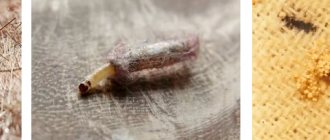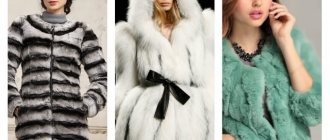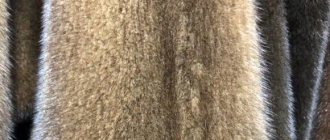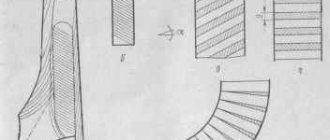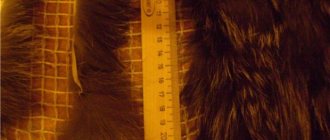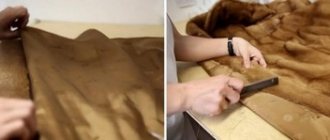A fur coat is a regal piece of clothing that is the ultimate dream for many of the fair sex. But it should be remembered that the end of the hassle of purchasing a fur beauty means the emergence of new ones related to preserving the beauty of your fur coat and increasing its service life, so our article is about how to properly store a mink coat in the summer at homewithout turning to specialists.
The most important point that you should know about and pay proper attention to is storing fur products at home. Not only the lifespan of fur, but also the preservation of its pristine beauty and majestic luxury directly depends on this.
Special conditions are a whim for an artificial one, but a severe necessity for a mink coat.
You can keep your fur coat in perfect condition only if certain conditions are met.
When buying an expensive coat or fur coat, you want to be irresistible and do not allow the thought that such clothing may become unusable. To prevent this from happening, it is necessary to create special storage conditions. Under the influence of various factors, such as increased air temperature, humidity or poor ventilation, natural fur can fade, turn yellow, lose wear resistance and become brittle . Hair may fall out, forming bald spots on clothing.
Advice!
But this, as a rule, does not apply to artificial material. A fur coat made of synthetic fibers is not afraid of sunlight, changes in temperature and humidity, and is also not of interest to moths.
Standard storage rules
Proper handling of the item during wear (in winter) and further storage will allow it to look good for a long time. In this case, you must adhere to the following rules:
- Do not allow sunlight to fall on the fur, and do not dry the item using a gas stove, fireplace or heating appliances;
- wet fur should be dried only at room temperature (the fur coat should hang on hangers);
- When wearing a fur product, you should not use handbags with a shoulder strap, backpacks, etc., so that the fur does not become wrinkled or frayed at the points of contact;
- When wearing or storing a fur coat, you should not spray aromatic products on it;
- You cannot decorate fur clothing with brooches and other decorations.
Before storing a fur coat in the summer, you should first check its condition. Take it to the dry cleaner and take other necessary measures to avoid doing this when cold weather sets in.
Additional recommendations
In order for a fur coat to serve for a long time and be pleasing to the eye, you must follow the general recommendations:
- The product must not be dried with electrical appliances or in the sun.
- You should not carry bags and backpacks on your shoulders - marks and scuffs will remain.
- If the product is exposed to snow or rain, it should be dried at room temperature on a hanger. It is forbidden to leave a fur coat near the fireplace or over the radiator!
- to pin various accessories to the product : such decorations spoil the appearance of the fur.
- Do not spray oils, perfumes, or other odorous products on the product.
A fur coat is an expensive pleasure that requires a reverent attitude on the part of the owner. In order for the product to maintain its appearance and shape, it must be properly cared for. By creating favorable storage conditions, every woman will protect this luxurious piece of clothing from external factors and parasites - as a result, the fur coat will serve the owner for a long time.
You can learn more about proper storage of fur coats by watching the video :
How to prepare real fur for storage
The winter season is over and it’s time to hide the fur coat until the next suitable occasion. What measures need to be taken to keep clothes in perfect condition? The procedure is as follows:
1. Initially inspect the fur product from the outside and inside. If necessary, fasten the buttons and replace the torn lining.
2. Then remove any dirt, if any. The easiest option is to take your fur coat to the dry cleaner. But you can get rid of stains yourself.
Advice!
A solution of 9% vinegar and vodka will help remove greasy marks. Mix the components in equal parts, moisten a sponge in the resulting mixture and wipe the contaminated areas with gentle movements. Treat fur coats covered with short pile against its growth. Brush long wool in the opposite direction - in the direction of the pile. After treatment, dry the fur coat in a ventilated area with a temperature of no more than 17 °C and a humidity of 50–65%.
3. If the fur is dull, wrinkled, or has accumulated dust, dry processing will be required.
Sprinkle potato starch evenly over the surface of the fur coat at the rate of 1 cup per 50 square meters. see fur. Wipe problem areas with a sponge. After cleaning, shake the fur coat well to completely remove any remaining powder. If the first cleansing does not give the desired result, the procedure can be repeated 2-3 times.
Advice!
There is an option to use rye or wheat bran or semolina instead of starch. But be aware that they will attract moths to the fur coat.
4. Comb the fur in the direction of the coat with a wide-toothed metal comb.
5. Air your fur coat outside or on an open balcony during the day.
6. After this, put the product on the hanger and fasten the buttons. The size of the hanger must match the product. Using too wide ones will lead to deformation, and on a narrow hanger the fur coat will sag.
... and conditions of detention
You also need to know how to store a mink coat in winter. To begin with, do not leave your fur coat hanging where it could be covered with other things. The fur may become deformed. Also consider four other tips.
- Do not hang the product by the loop. Only a hanger with wide hangers. Otherwise, the leather fabric will stretch and the fur coat will lose its shape.
- Do not leave near heating devices. Hot air damages the pile and the leather fabric loses its elasticity.
- Do not hang it on the balcony. Direct rays of the sun fall there, which can change the color of the product.
- Don't spray perfume. Stains may remain and the fur will lose its shine.
Preventing moths
The cover, unfortunately, does not protect the fur from moths. Therefore, it is advisable to treat the material with a special spray or aerosol . Insecticides in the form of sprays are widely available on sale. On the packaging of such a product there are instructions for use, which indicate the frequency of processing. For example, Mosquitall, Tornado or Raptor. This impregnation must be renewed every 3 months, as it loses its properties.
Advice!
Do not spray your fur coat, otherwise marks will remain on it; apply the product exclusively to the cover.
Don't forget to put moth repellent in the closet or spray the cover of your fur coat.
You can put pieces of cedar bark in your pockets: moths do not tolerate this aroma, and, accordingly, will not encroach on the fur coat. In addition, its smell does not disappear. Dry geranium, lavender or citrus peels are also suitable for this purpose. But folk remedies are inferior in effectiveness to aerosols and sprays. Do not use naphthalene. It repels moths well, but is a carcinogen, which is why many countries have banned its use for several years.
But home remedies for combating voracious insects are inferior in terms of effectiveness to high-quality aerosols.
If the moth has finally reached the fur coat, it will be noticeable immediately. The pile will lie sloppily and bald spots will form in it. When shaking the item, pieces of wool that the moth has managed to damage will separate from it. And the larvae of this pest will be present in the folds.
If the presence of moths in a fur coat has become obvious, you should not hesitate, you need to act urgently.
The first step is to use a powerful insecticide. If everything is done in accordance with the instructions of the drug, within the next hour or two you can deal with the moth and prevent the insects from completely destroying the coat.
If moths are present, the fur is treated with an aerosol, put in a cover and left there for several days. If the cover does not close completely, the item is placed in a tight polyethylene bag and treated with the drug every day so that its effect does not weaken.
Choosing a case
Fur should be stored in colored cases made of natural fabric.
Under no circumstances should a fur coat made from natural fur be stored without a cover. Otherwise, the product will fade, become wrinkled and lose its luxurious appearance forever. The cover must be fabric. Vacuum bags for storing fur products are contraindicated. The fact is that, firstly, the fur coat will have to be folded, since it is almost impossible to find a cover of a suitable size. And secondly, condensation forms in a closed bag, which negatively affects the villi and inner parts - treated leather, the basis for fur. So, what are the requirements for a fabric cover?
- It should be breathable and made of natural fabric (linen, cotton, canvas).
- The width of the bag should be slightly larger than the width of the fur coat.
- The length should be 10–15 cm longer than the fur product.
- The insert on the cover should be located on the side - this is the only way the fur coat will not be squeezed, and it will be much more convenient to pack it.
- It is better if the cover has a transparent “window” - when storing several fur items in one closet, it will be more convenient for you to figure out which is which.
- The sun's rays should not fall on this transparent insert, since ultraviolet radiation negatively affects fur even through polyethylene.
- The color of the cover should repel sunlight, so rich blue, dark brown, and black are preferred (to prevent the paint from transferring to the fur coat, when purchasing a packaging bag, run a damp cloth along the inside - if there are no marks left, you can buy).
- Before placing the fur coat in the cover, treat it with anti-moth spray, and then repeat the treatment every 3 months.
Subtleties of home storage of different furs
Each type of fur has its own wear and storage period. To keep your clothes in perfect condition, you need to remember a few simple rules.
Mouton
The most durable is the mouton. This fur coat is often used as an everyday option. They store it, like others, in a dark, well-ventilated closet. But mouton fur has one peculiarity - if the dirt is not removed from it immediately after the stain appears, then it will be almost impossible to do so later. Therefore, the fur coat must be thoroughly cleaned before storage.
Mouton is stored for a long time in cold and dry conditions. The enemy of the muton is heat . The product is placed in a closet where even artificial light does not penetrate. The optimal temperature is 8–12 °C, otherwise the fur may lose its shine and acquire a musty smell of rags. To protect the mouton from deformation as a result of its own weight, the hangers must be exactly the width of the shoulders of the product.
Mink
Mink is a capricious and not wear-resistant fur . This product should be stored hanging on soft hangers. A suitable option is a cabinet made of cedar, since such wood practically does not allow moisture to pass through and repels moths with its smell. It is advisable to choose a storage case made of fabric to ensure sufficient breathability.
Mink is a delicate material that requires care
Before storage, be sure to clean the fur from dirt; it is advisable to entrust this process to dry cleaning specialists. Mink is a very delicate material that can be easily damaged.
How to store products made from nutria, goat and other types of fur
Nutria and beaver fur is the most wear-resistant and durable. Such fur coats will last for many years, maintaining their appearance unchanged. But there are still some storage nuances.
- The beaver product should be kept in a cool, dry room. Exposure to dampness and heat instantly spoils a fur coat, making it faded.
- Nutria fur is more durable. It is enough to protect it from moth attacks. Both of these materials must be thoroughly dried before being put into the closet.
- Rabbit fur is stored in the same way as mink. It is important to prevent caking of the product, as well as moth attacks.
- The fur of raccoons, foxes and chinchillas is easily susceptible to creases. Products are stored only on hangers. In this case, it is necessary to ensure that they are well straightened.
- A goat fur coat is placed on wide hangers, this allows it to maintain its shape. Otherwise, the storage conditions are not particularly special.
Wardrobe, balcony or freezer - which room can be used for summer storage?
The most important rule when choosing a room is to avoid high humidity. Fur coats should be stored in a cool, dark and dry place . Optimal temperature is 15–17 °C, humidity is 40–65% . This could be a closet or dressing room. The required temperature values can be achieved using an air conditioner.
A balcony is not suitable for this purpose, since in summer it is too hot in this room.
For good preservation of fur you will need a spacious and dark closet.
Important! Do not place the product near lighting fixtures, and also avoid direct sunlight.
Also, the room should be well ventilated and spacious. You need to create enough free space in the closet, since the fur coat should not come into contact with other clothes .
Important! If the fur is hung in tight spaces and squeezed, the fur will quickly lose its shape.
Some women practice storing fur coats in the freezer. Low temperatures really have a beneficial effect on the preservation of fur. But this is a very controversial option. There is no way to hang a fur coat in a household freezer; it will have to be stored rolled up, and as a result, creases may form.
Be that as it may, today many dry cleaners offer storage in special refrigerators. If you choose this option, take an interest in the conditions in which your fur coat will be placed. Signs of proper storage are dim light, temperature from 2 to 8 degrees, humidity no more than 65%, placement of fur coats at a distance of 10 cm, packaging of products in a case, the presence of freezing programs, which allows you to destroy all insects. Make sure that the camera is not exposed to direct sunlight.
What can happen if you don't follow the rules?
A fur coat is a fairly expensive wardrobe item that requires careful storage. Let's look at the most popular fur storage mistakes and possible methods for eliminating them.
Moth damage
It’s not difficult to hang a moth sachet in your closet, but if you forget about this easy care measure, the result will be almost irreparable: a moth-ridden fur coat loses all its charm.
Careless storage can result in damage to the fur coat.
Advice!
You cannot store household chemicals in the closet at the same time as your fur coat. If the cleaning agent gets on the fur, it will no longer be possible to restore it.
Creases on a folded product
If you store a fur coat folded, it will inevitably become wrinkled. If the bruises are not severe, then to bring it into proper condition, you will need a hanger, a fur brush or a foam sponge.
You can try to straighten your fur coat in two ways:
- The first one is to use steam. First, turn on the hot water in the bathroom. When steam forms, place the fur coat on a hanger. It should remain in the bathroom until it is completely smoothed out. After this, shake the product well and dry in a ventilated area. Do not keep your fur coat in the steam for longer than necessary, otherwise it will become deformed.
- If the fur coat is slightly wrinkled, you can resort to the second method. Wet the sponge and carefully go over the problem areas in the direction of the pile. Then comb the fur and dry the coat. If necessary, repeat the alignment.
Drying of the flesh
When storing the product in conditions of low humidity or high temperature, drying out of the core may occur . The flesh is the processed skin on which the fur is located.
Important!
With an increased level of humidity, the inner layer, on the contrary, stretches.
You can try to soften dried, hard pulp with a solution of 1 liter of water, 1 tbsp. l. vinegar and 50 g of salt. Apply this mixture to the inside of the skin for 2 hours. Then mash the flesh and rinse with water.
A mixture of soap solution is also suitable for this purpose, to which you should add ¼ of its volume of fat and 1/10 of glycerin. Treat the flesh with this mixture and leave it for 5 hours. Then rinse and rub the skin with chalk to remove any remaining oil.
Important!
If the membrane is overstretched, normalize the humidity levels in the room.
Yellowness on white fur and fading of dark fur coats
When exposed to sunlight, the fur loses its color. Dark fur coats may fade, and light fur coats may turn yellow. In the first case, proceed like this:
- soak a cotton pad in a 9% vinegar solution and treat problem areas;
- take a napkin, apply alcohol to it and wipe the fur until it is dry;
- Comb the product and hang it to dry.
If the fur coat is made of tsigeika or astrakhan fur, your actions should be the opposite. It should be dried first and only then combed.
As a result of violation of storage rules, yellowness appears on light fur. In addition to the influence of ultraviolet rays, this is caused by the ingress of dust, soot, perfumes and cosmetics.
Advice!
Don't spray perfume on your fur. It absorbs aromas well, but over time the smell will change and become unpleasant.
Dry cleaning will help get rid of such marks. But only if the damage is minor and formed recently. If the yellowness is significant, exposure to chemicals will further aggravate the situation. In this case, you can take a risk and resort to home methods.
Sorbents have bleaching properties. For example, semolina, bran or starch. Processing options:
- Lay out the fur coat, apply sorbent (semolina, wheat or rye bran must first be heated in a dry frying pan for a few seconds) and rub it into the fur. Then shake the product and comb. This is the most gentle bleaching method, so it may leave yellow areas. In addition, if semolina is poorly combed, it will attract moths.
- The second method is more effective. Dilute 3% hydrogen peroxide or ammonia in equal proportions with water in a 1:2 ratio, moisten a cloth and wipe the yellowed areas. There is no need to rinse off the solution.
- If the previous two methods did not help eliminate the problem, you can use whitening shampoos for animal hair. For example, All Sistem Whiteninq, HERBAL WHITENING SHAMPOO. However, the fur coat cannot be washed. Dilute a few drops in water and treat the fur with a sponge.
If after all the above methods the fur has not acquired its original color, it needs to be dyed. But under no circumstances should dyeing be done at home. Take the fur coat to a studio that provides this service .
